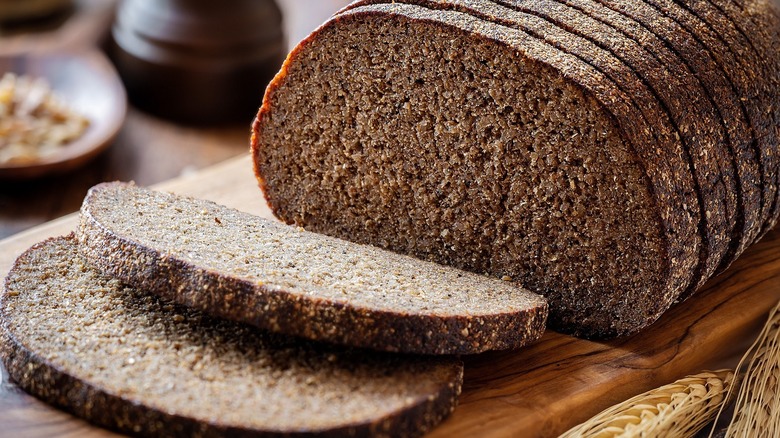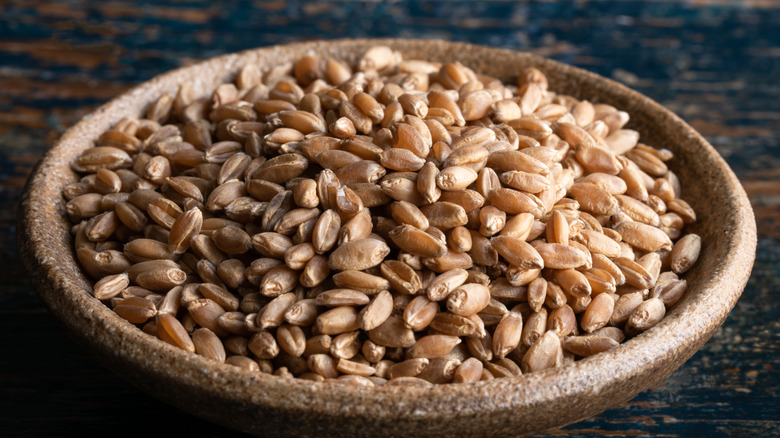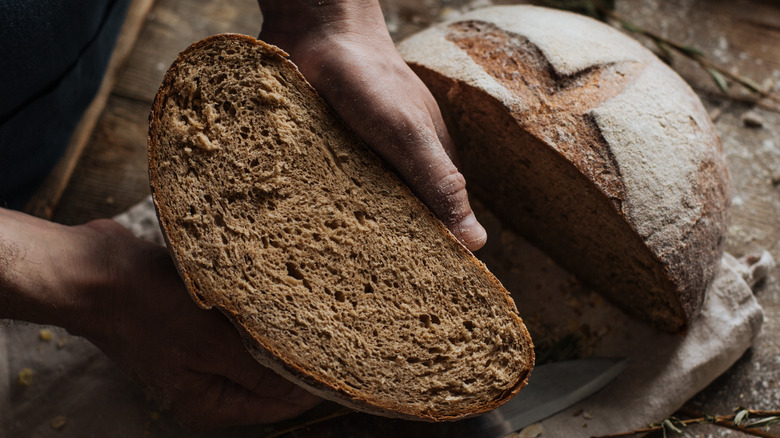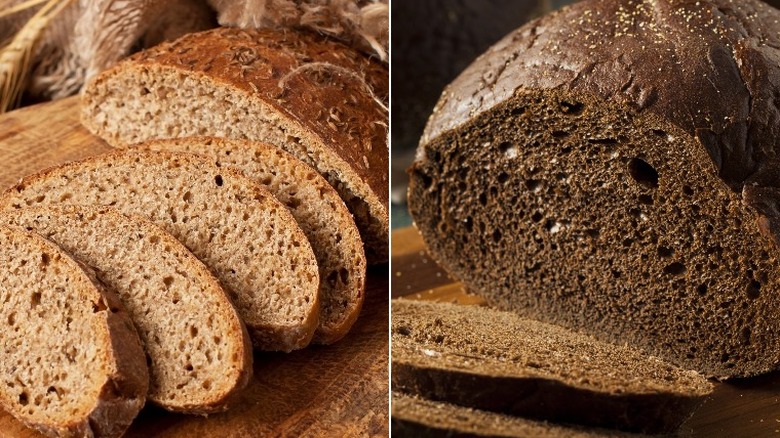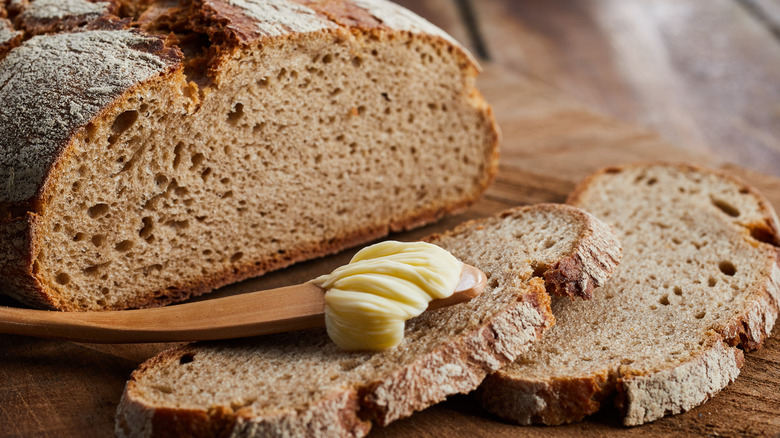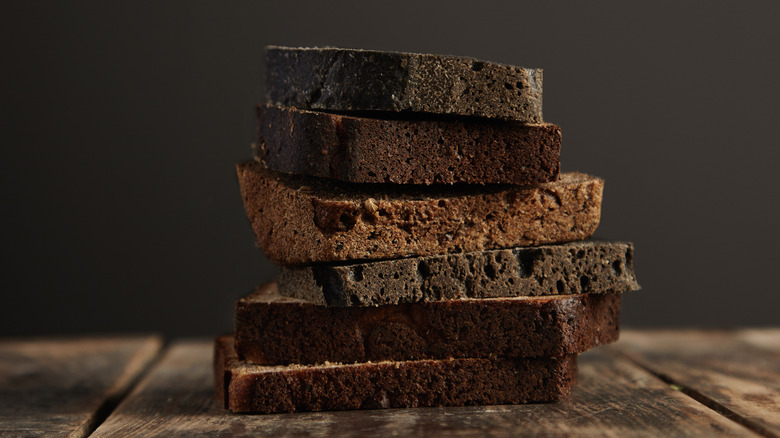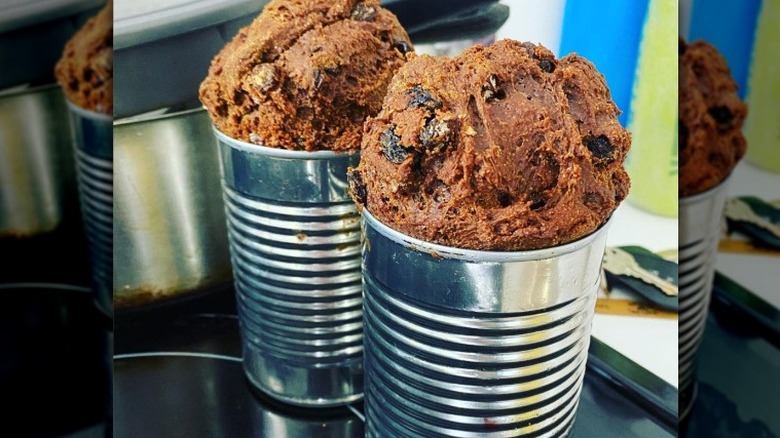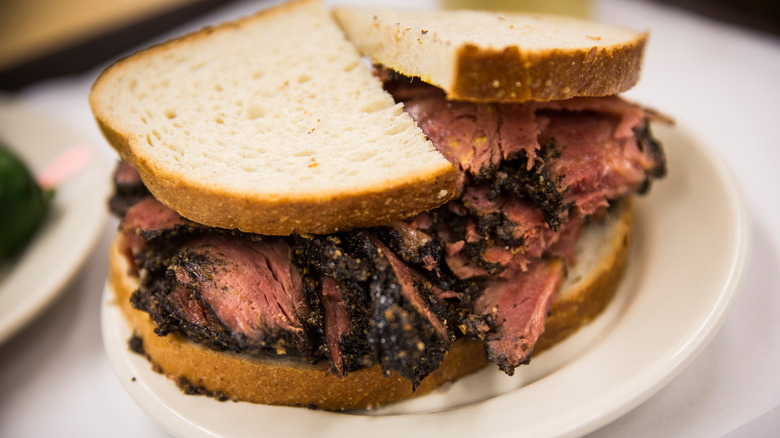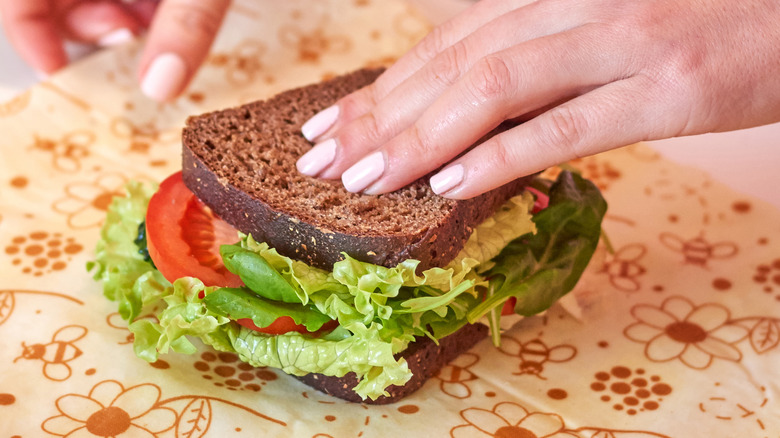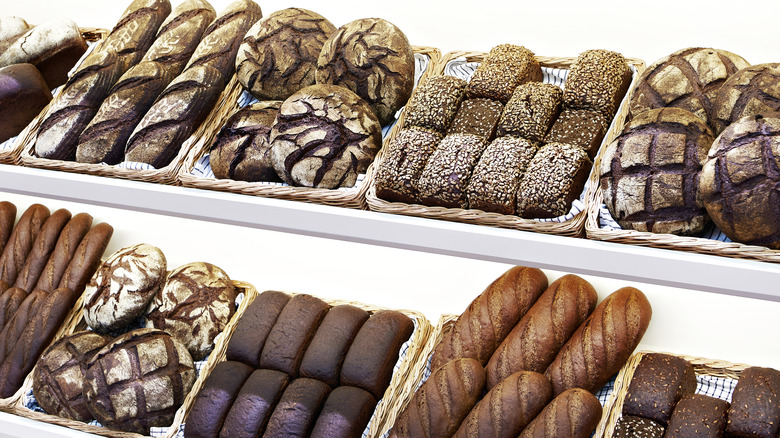What Is Rye Bread And Is It Nutritious?
We may receive a commission on purchases made from links.
Order sandwich classics like a savory patty melt or a pastrami-filled Reuben and, if they're the real deal, they'll be served on slices of flavorful rye bread. According to MasterClass, loaves of rye can look very different depending on what type they are and who makes them. Some loaves are dark as night with a dense texture, some have a color and softness closer to that of wheat bread, and some bring together light and dark doughs in a swirl pattern. Rye breads may also be studded with seeds or fruit.
One thing that all rye breads have in common? Their grain. The way the grains are processed to make rye flour contributes to the intense color and flavor of rye breads. The New York Times shares that hearty rye bread has a long history in Russia, northern Europe, and Scandinavia, where it was a dietary staple for centuries before lighter wheat and white breads became popular across the world. Interest in ancient grains like rye has grown in recent years, with more hobby and professional bakers exploring the distinctive flavors and health benefits of traditional breads. That's good news for home bakers, because rye recipes are now easy to find and ingredients are more widely available. Here's everything you need to know about rye bread.
What exactly is rye?
To understand rye bread you first have to understand the grain behind it. According to MasterClass, rye (Secale cereale) is a type of cereal grass in a family that includes wheat, millet, and barley. Britannica shares that as a farm crop rye is extremely hardy, thriving in poor soils where other crops would struggle and in climates as cold as the Arctic Circle. It's been grown for millennia across Asia, Russia, and Northern Europe, and is also successfully grown in North America. Rye grains and berries can be cooked and eaten like other whole grains, and are used in brewing to create rye whiskeys and uniquely flavored beers. And of course, rye can be ground into flour to make baked goods like bread.
Breads made from 100% rye flour are darker than those made with a blend of rye and other flours like wheat. Because rye has such a strong and distinct flavor, blending it with other flours also results in a milder rye flavor. According to King Arthur Baking Company, the type of flour used also affects color and flavor. The lightest ones are made from grains that have had the bran and germ removed. Medium rye flours have more of the bran intact, and dark flours like pumpernickel are milled from the entire grain. Some of the breads made with rye flour include black bread, light rye with caraway seeds, pumpernickel, and sourdough rye (via The Spruce Eats).
Rye bread bakes up differently than other loaves
According to King Arthur Baking Company, the baking process for rye bread is similar to other breads, but because rye flour has a relatively low amount of gluten – the protein that gives bread structure and helps with rising — the differences are very important. Bakers often mix rye with higher-gluten flours or additives to get a better and faster rise from the dough.
The amount of gluten, plus the type and amount of rye flour being used, means that rye loaves may require longer rising and baking times than other breads. For example, King Arthur Baking's recipe for Chewy Semolina Rye calls for a blend of semolina, wheat, and rye flours, and has rise and bake times much like those of regular wheat loaves. In contrast, their recipe for Westphalian Rye, made with a large quantity of dark rye flour, needs about 14 hours of rising time and five hours to bake! Rye dough will also feel heavy, sticky, and less smooth than other doughs.
Masterclass notes than some rye bread recipes include a sourdough starter or acidic ingredients like pickle juice, which react with the rye flour to leaven the dough and give it a pleasant tanginess. Other techniques that set rye breads apart, per King Arthur Baking, are using a "soaker" — a wet piece of old rye bread placed in the dough for added flavor — and long periods of steam-cooking to create a light and moist texture.
The difference between rye and pumpernickel
The term "rye" is used in a generic way to describe many kinds of rye bread, including light, medium, and even marbled varieties (via The Kitchn). This makes it difficult to know exactly what you're getting when picking up a loaf or ordering a sandwich. According to King Arthur Baking Company, light-colored rye breads are made using the mildest rye flour milled to remove the bran and germ. It's also common for American-style ryes to be made from a blend of rye plus wheat or white flours. These breads have a mellow flavor, light and airy texture, and may contain caraway seeds.
What people might not realize is that the dark bread labeled as pumpernickel is also a type of rye — however, even these loaves can be confusing. Per Masterclass, the traditional pumpernickel loaves of Europe are made with 100% whole-grain rye flour, creating a bread that is dark, strongly-flavored, and requires a long, low-heat bake time. In the U.S. however, unless you're getting loaves from a bakery specializing in artisan and European breads, pumpernickel bread is just light rye with coloring added. Ingredients like coffee, cocoa, or molasses give the bread a dark hue, but the flavor will be the same as that of mild, light rye.
What does rye bread taste like?
As King Arthur Baking notes, when people think of rye, they think of a distinct, spicy flavor with hints of pepper, licorice, and citrus. What they don't realize is that those flavors aren't from the rye — those tastes come from the caraway seeds often added to loaves of Jewish rye and many supermarket rye breads. This means that many who think they don't care for rye may really only dislike those caraway seeds!
The flavor that rye flour does give to bread is a complex one that can be described as "nutty, earthy, and slightly malty." For loaves made with darker, more whole grain rye and higher quantities of rye flour, that flavor is even more pronounced. Michigan's legendary Zingerman's Delicatessen says that good rye breads have a sourness, especially in loaves made with sourdough starter or a soaker made of the previous day's rye bread. Rye is also a little sweet, thanks to the long baking times that caramelize the sugars. The texture is important, too; slices should have a decent amount of chewiness. Zingerman's cleverly describes rye as the bass note of breads: "Steady, delicious, never wavering ... good rye has guts."
Rye breads of Europe and Russia
Rye has a long history across Europe and Russia, according to the New York Times. In his book "The Rye Baker: Classic Breads From Europe and America," baker Stanley Ginsburg categorizes rye breads by region. In the book's index, the ryes of Holland, Denmark, and Northern Germany are described as "robust and complex." Recipes from Ginsburg's website for these regions include coarse buttermilk Vollkorn and the rustic, seeded Das Saftige loaf. The breads of Finland and Sweden are classified in Ginsburg's book as "sweet and crisp;" recipes on his site range from Finnish malt bread to ruisreikäleipä (ring-shaped rye.) Russian and Baltic rye breads are "dark and intense." Ginsberg's recipes from these regions include Lithuanian black rye bread and dark Moscow rye with caraway seed.
As for pumpernickel, when a baker on "The Great British Bake Off" told Paul Hollywood about American-style pumpernickel, Hollywood informed the baker with an icy stare that "There's only one pumpernickel, and that comes from Germany" (via Twitter). Foodal notes that pumpernickel bread did indeed originate in the Westphalia region of Germany. And because the heavy, coarse-textured bread can be tough on the digestive system, the name pumpernickel translates to "demon's fart."
American varieties of rye bread
The New York Times explains that lighter-colored, seeded rye loaves we're familiar with in the states are much like traditional breads made by Jewish bakers in southern Poland and Ukraine. When these Jewish bakers and families immigrated to the U.S., they brought their rye bread traditions with them. According to Serious Eats, another type of Jewish rye bread that originated in this region and is made in the U.S. is kornbroyt, or corn rye, made with rye flour, rye starter, and cornmeal.
Another American rye is the Boston or Rhode Island brown bread. This type is also made with a mixture of rye flour (and sometimes wheat flour) and cornmeal, but includes buttermilk, molasses, and baking soda (via King Arthur Baking). When baked or steam-cooked it's very dark and moist, and sometimes will include raisins or other dried fruits. As Martha Stewart notes, Boston brown bread is traditionally steamed in a can which turns out a cylindrical, ribbed loaf.
Stanley Ginsburg shares on his website The Rye Baker that there's a type of heirloom rye grown in South Carolina known as seashore rye which has a less intense flavor than other rye grains. Recipes in Southern cookbooks use flour made from seashore rye in combination with cornmeal to make a textured, mild-flavored rye bread with only a hint of sweetness.
The best ways to enjoy rye bread
When looking for a way to enjoy rye bread, sandwiches are a natural place to start. The mild flavor of light rye bread makes it very versatile — beloved delicatessens like Katz's in New York City serve their "legendary" pastrami piled high on slices of deli rye, and pair the bread with corned beef and brisket in classic sandwiches like a Reuben. At Zingerman's Deli in Ann Arbor, Michigan, rye bread is used for sandwiches like a turkey-version of a Reuben (also known as a Rachel) as well as some with sliced chicken or tuna salad. American-style mild pumpernickel or marbled pumpernickel-rye can be enjoyed the same way as light deli rye bread.
The Rye Baker's Stanley Ginsburg suggests pairings for European rye breads, like enjoying Latvian coarse rye with charcuterie, liverwurst, or with a hearty soup. Many of the dark breads are enjoyed simply with butter so that their intense flavors can be fully experienced. The sweet Finnish malt bread can even be incorporated into a dessert, layered with whipped cream and berry jam. Ginsburg likes slices of dark and coarse Vollkorn Roggenbrot with thinly sliced smoked salmon and cream cheese.
If you're trying the dark, authentic German pumpernickel, Foodal suggests spreading butter with honey or jam on the slices for a sweet-bitter balance. It's also delicious with slices of roast beef and horseradish, or with mild cheese and sliced veggies.
Is rye bread nutritious?
Because rye bread can be different depending on the blend and type of flours, Healthline says that the nutritional stats between loaves will also vary. On average, a slice of rye bread has 83 calories, 15.5 grams of carbohydrates, and 2.7 grams of protein. Rye bread also has more fiber than other breads (almost two grams per slice) and higher levels of nutrients like vitamin B6 and selenium. Although rye flour has less gluten than wheat flour, it's still enough of the protein that it can't be consumed as part of a gluten-free regimen — plus, many rye breads are made with a blend of rye and higher-gluten flours.
Well and Good notes that the high-fiber content of rye bread means it's more filling than other breads, and eating more fiber can help manage high blood pressure and heart health. They recommend skipping rye loaves made with refined flours and looking for those made with whole-grain rye berries and rye flour. As King Arthur Baking notes, breads made with dark rye flour are closer to whole-grain than those made with lighter varieties.
How to get your hands on rye bread
You can find several brands of rye bread at grocery and retail stores like Target, including Pepperidge Farm Deli Swirl, Beefsteak, and Dave's Killer Bread. It's also worth your time to explore local bread bakeries, especially those who use ancient grains or make traditional Jewish and European breads. Getting your rye bread from bakeries means you can ask the bakers about the type and amount of rye flours used, not to mention that you'll experience fresh-baked bread made without preservatives.
If you want to try making rye at home there are lots of recipes available in cookbooks and online, thanks to increased interest in recent years in traditional breads and ancient grains. Stanley Ginsburg's book "The Rye Baker" (available on Amazon) includes a wide variety of rye bread recipes and history from across the world. King Arthur Baking Company also has several recipes for breads like sourdough rye, Westphalian rye, and marbled rye; the company also sells several rye flours to help you get started.
If you're curious to try Boston Brown Bread made inside a can, this recipe from Serious Eats is easy to make. Amazingly, you may even find this bread in a can on your grocery store shelf! The company famous for their beans, B&M, sells canned brown bread — with or without raisins.
